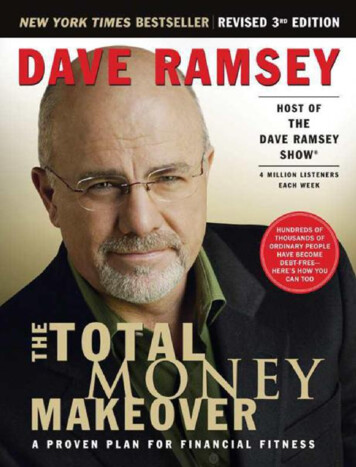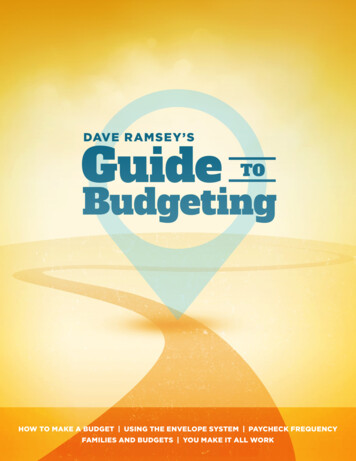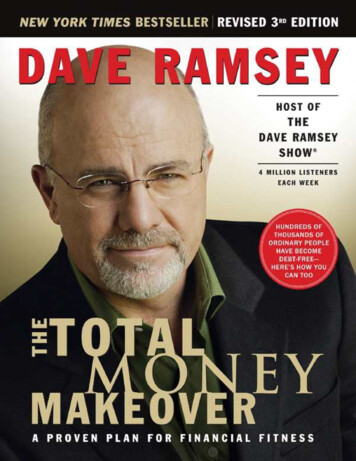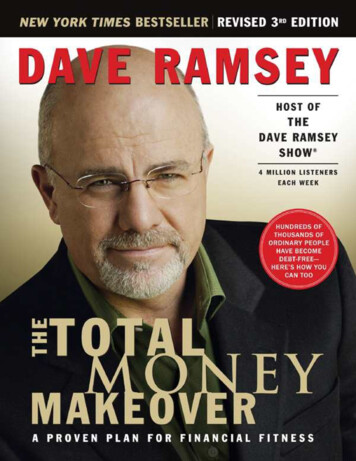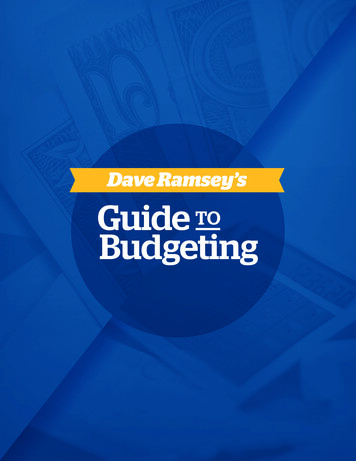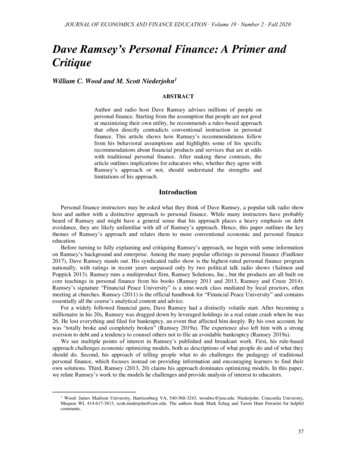
Transcription
JOURNAL OF ECONOMICS AND FINANCE EDUCATION Volume 19 Number 2 Fall 2020Dave Ramsey’s Personal Finance: A Primer andCritiqueWilliam C. Wood and M. Scott Niederjohn1ABSTRACTAuthor and radio host Dave Ramsey advises millions of people onpersonal finance. Starting from the assumption that people are not goodat maximizing their own utility, he recommends a rules-based approachthat often directly contradicts conventional instruction in personalfinance. This article shows how Ramsey’s recommendations followfrom his behavioral assumptions and highlights some of his specificrecommendations about financial products and services that are at oddswith traditional personal finance. After making these contrasts, thearticle outlines implications for educators who, whether they agree withRamsey’s approach or not, should understand the strengths andlimitations of his approach.IntroductionPersonal finance instructors may be asked what they think of Dave Ramsey, a popular talk radio showhost and author with a distinctive approach to personal finance. While many instructors have probablyheard of Ramsey and might have a general sense that his approach places a heavy emphasis on debtavoidance, they are likely unfamiliar with all of Ramsey’s approach. Hence, this paper outlines the keythemes of Ramsey’s approach and relates them to more conventional economic and personal financeeducation.Before turning to fully explaining and critiquing Ramsey’s approach, we begin with some informationon Ramsey’s background and enterprise. Among the many popular offerings in personal finance (Faulkner2017), Dave Ramsey stands out. His syndicated radio show is the highest-rated personal finance programnationally, with ratings in recent years surpassed only by two political talk radio shows (Salmon andPoppick 2013). Ramsey runs a multiproduct firm, Ramsey Solutions, Inc., but the products are all built oncore teachings in personal finance from his books (Ramsey 2011 and 2013, Ramsey and Cruze 2014).Ramsey’s signature “Financial Peace University” is a nine-week class mediated by local proctors, oftenmeeting at churches. Ramsey (2011) is the official handbook for “Financial Peace University” and containsessentially all the course’s analytical content and advice.For a widely followed financial guru, Dave Ramsey had a distinctly volatile start. After becoming amillionaire in his 20s, Ramsey was dragged down by leveraged holdings in a real estate crash when he was26. He lost everything and filed for bankruptcy, an event that affected him deeply. By his own account, hewas “totally broke and completely broken” (Ramsey 2019a). The experience also left him with a strongaversion to debt and a tendency to counsel others not to file an avoidable bankruptcy (Ramsey 2019a).We see multiple points of interest in Ramsey’s published and broadcast work. First, his rule-basedapproach challenges economic optimizing models, both as descriptions of what people do and of what theyshould do. Second, his approach of telling people what to do challenges the pedagogy of traditionalpersonal finance, which focuses instead on providing information and encouraging learners to find theirown solutions. Third, Ramsey (2013, 20) claims his approach dominates optimizing models. In this paper,we relate Ramsey’s work to the models he challenges and provide analysis of interest to educators.1Wood: James Madison University, Harrisonburg VA, 540-568-3243, woodwc@jmu.edu. Niederjohn: Concordia University,Mequon WI, 414-617-3813, scott.niederjohn@cuw.edu. The authors thank Mark Schug and Tawni Hunt Ferrarini for helpfulcomments.37
JOURNAL OF ECONOMICS AND FINANCE EDUCATION Volume 19 Number 2 Fall 2020Ramsey’s Fundamental AssumptionThe tradition of economics is to assume that people are good at maximizing their own utility, and totreat personal finance as information and techniques that improve the maximization process. Ramsey’sapproach starts with the opposite assumption: that people are not good at maximizing their own utility.Ramsey’s consumers stumble from mistake to mistake, with overconsumption and excessive debt chiefamong them.To counter these mistakes, Ramsey recommends a variety of tricks and methods for reducing currentconsumption and saving more for the future. The techniques include a written budget (Ramsey 2011, pp.54-56), a monthly cash envelope system (Ramsey 2011, pp. 68-69), and a rigid 15 percent retirementsavings goal (Ramsey 2011, pp. 222-223). Ramsey frequently writes and speaks on the assumption that hiscallers are not optimizing. Figure 1 illustrates.Figure 1: Current and Future ConsumptionHouseholds have preferences across current and future consumption, usually interpreted as “workinglife” vs. “retirement.” Households start with current and future incomes that place them at point A on thekinked line. The kink comes from households facing different interest rates for borrowing and saving.Moving downward to the right from A, households get a relatively small amount of additional currentconsumption compared with the future consumption they will give up as they borrow at relativelyunfavorable interest rates (say, 18 percent on credit card balances). Moving upward to the left from A,households face the relatively flat slope embodied in the interest rates they receive (for example, as holdersof certificates of deposit.) Those who save nothing for the future remain at A and enjoy lifetime utility lessthan U3. If rational optimizing households save for retirement, they achieve the highest possible lifetimeutility, U3, by moving to point B—giving up current consumption but getting greater future consumptionthey value more highly. Differing tastes for current and future consumption are represented by the slopes ofthe utility curves, with flatter curves reflecting greater patience and a willingness to defer consumption nowfor greater consumption in the future.Ramsey’s callers, as non-optimizers, often appear not to recognize the tradeoffs. If Ramsey’s callerswere thinking in terms of Figure 1, they would know that they were at a point like point C. They may noteven have enough information to realize they are at a point like C. Instead of saving for the future, theyhave done the opposite, using credit to expand current consumption at the expense of the future. Callerscould increase their utility level by getting out of debt and saving. Thus, Ramsey’s techniques for gettingthem to cut current consumption move them toward a point they would prefer, if only they could get there.To be sure, it is possible that some individuals do not value retirement or perhaps do not believe thatthey will be alive to enjoy it. A high degree of current consumption is rational for these individuals, asillustrated in Figure 2. Their steep utility curves reflect a strong desire to consume now rather than in thefuture. For such consumers, moving to point B by saving more for retirement would result in a lower utilitylevel (U2 instead of U3). Those seeking Ramsey’s advice, however, seem not to be consuming rationally,but instead to have wandered into a consumption pattern they would prefer to avoid. More generally,Americans’ biggest financial regret is consistently reported as not saving enough for retirement or notstarting to save for retirement soon enough (Smith 2019).38
JOURNAL OF ECONOMICS AND FINANCE EDUCATION Volume 19 Number 2 Fall 2020Figure 2: Current and Future Consumption with Present-Oriented PreferencesInterestingly, Ramsey’s rule to save 15 percent of gross income for retirement is not just a floor but alsoa ceiling, derived from rough experience-based optimization (Ramsey 2011, p. 223):Why not more? You need some of your income left to do the next two steps, college savings andpaying off your home early. Why not less? Some people want to invest less or none so they can get achild through school or pay off the home superfast. I don’t recommend that because those kids’college degrees won’t feed you at retirement.However, Ramsey rarely needs to counsel against saving too much for retirement. This is notsurprising, given both the audience for his show (unlikely to include many people who are confident intheir financial future) and the imperatives of the talk radio format (with its need to get dramatic stories pastthe call screener and on the air).Under Ramsey’s fundamental assumptions, people are not just non-optimizing, but all too often“stupid.” Ramsey (2019b) once told a caller, “When I do something stupid that costs me money, I call itstupid tax.” Examples include cosigning a loan for a wasteful relative (Ramsey 2019b) and making a loanto an ex-girlfriend (2019c). The stupid tax involves spending in ways that do not increase utility and, inthese examples, make relationships worse.Consumers paying a stupid tax have no place in traditional optimizing economic theory. We do findthem, however, in the increasingly prominent (Costa et al. 2018) behavioral finance and behavioraleconomics schools (Thaler and Sunstein 2008), doing such things as: Exhibiting a “status quo bias” (Samuelson and Zeckhauser 1988) that freezes them in place,preventing them from moving. Someone who says “I will always have a car payment” and thereforerules out working toward a car payoff is exhibiting a status quo bias. Making bad decisions on probabilistic matters (Tversky and Kahneman 1974), such as buyingoverpriced extended warranties. They fail to correctly weigh the low probability and limited payoff ofan overpriced extended warranty compared with the up-front and certain large premium. Knowing credit card debt is bad, even while assuming that everyone has excessive credit card debt,falling prey to a “herd mentality.” They feel secure following what they think the herd is doing, even ifthey are incorrect about the herd.Ramsey does not think the caller facing a car repossession needs better optimization instructions, butinstead the motivation to stop doing stupid things and then to start saving. Given Ramsey’s total rejectionof optimizing models, we wondered whether his work is unfamiliar to academic economists. A full-date,full-text search of the American Economic Association’s ECONLIT database turned up only five totalreferences to Ramsey. Among those, only two formally cited Ramsey–and even then, the citation was to hiswebsite and not any published work. Thus, there are millions of people taking financial advice that isvirtually unknown within academic economics. We note this not to disparage the advice, but to emphasizethe different knowledge sets of the two groups.Ramsey’s fundamental assumption of non-utility-maximization, influenced by his own bankruptcy,leads to an aversion to debt in all its forms, on both the borrowing side and the lending side. This aversion39
JOURNAL OF ECONOMICS AND FINANCE EDUCATION Volume 19 Number 2 Fall 2020includes recommending an asset allocation of 100 percent stock and 0 percent bonds for investors,regardless of age, in order to avoid participation in debt. Ramsey frequently tells his audience, “Theborrower is a slave to the lender,” citing Proverbs 22:7 (Ramsey 2011, p. 94). Ramsey also mocks hisformer finance professors, optimizers who taught that debt was a tool and “were all broke” (Ramsey 2011,p. 93). Ramsey claims as his most important qualifying credential that “I have done stupid things withzeroes on the end,” adding “I have a Ph.D. in D-U-M-B.” (Ramsey 2013, p. xvii).Ramsey celebrates the end of indebtedness with those following his plan using a radio programmingfeature called the “Debt Free Scream.” The individual or household newly out of debt is led through aserious of questions (Ramsey 2019d) about how much debt was paid off and how long it took. Individualmotivation tips and stories are also included. When the questioning is done, there is a countdown, “3-2-1,we’re debt free!” followed by cheering and studio sound effects. To qualify for a debt free scream, theindividual or household must be truly debt free, not even holding a credit card. To Ramsey, theconvenience and incentives of a credit card, even one paid off monthly, do not justify the use of a debtinstrument.To fully appreciate Ramsey’s aversion to debt, consider his advice on credit scores—not how to raisecredit scores, but how to have no credit score at all. Ramsey explains that someone with no active creditaccounts and no activity in the past six months will not have a FICO (Fair Isaac) credit score at all (Ramsey2011, p. 108). This stands in sharp contrast to the near-universal personal finance advice to maintain a goodcredit score (for example, Billingsley et al. 2017 and Howard 2019). Ramsey acknowledges theinconvenience of not having credit or a credit score, but he considers being debt-free to be a sufficientoffsetting reward.Ramsey’s model makes sense for consumers who do not trust their ability to manage debt or who havea moral objection to debt. It does not appear to be optimizing for other consumers. The rational consumerwho can borrow at 5 percent and make a 6 percent return on assets can, over time, multiply personalwealth. Ramsey’s approach gives up this potential return. This issue comes up frequently when callers balkat Ramsey’s advice to sell off stocks to extinguish a home mortgage. Ramsey asks them to consider theirsituation if they had a paid-off home and no debt. Would they go into mortgage debt to invest in stocks?The usual answer is “of course not.” Ramsey’s reversal of the question relies on risk aversion and alsoinvokes psychic benefits: “When you pay off your house and burn the mortgage, take off your shoes andwalk through the backyard. The grass feels different under your feet” (Ramsey 2019e).Evaluation of Financial ProductsStarting from non-utility-maximization, Ramsey’s rule-based approach calls for avoiding certainfinancial products and embracing others–without further analysis. Because of the difference in approaches,his advice tends to vary in tone and substance from traditional personal finance advice. Here are somefinancial products that Ramsey dismisses and the often-contrasting perspectives from conventional personalfinance textbooks: Automobile leases: Ramsey says that leasing a car “is the worst possible way to acquire a vehicle”(Ramsey 2013, p. 32) and repeatedly refers to a lease as a “fleece.” Typical personal financial planningtextbooks (Billingsley et al. 2017, p. 164; Kapoor et al. 2019, p. 305) take a different approach. Keown(2019, p. 250) writes, “And don’t forget about the option to lease,” while Ramsey’s message is to forgetabout the option to lease. Billingsley et al. (2017) concede the point that a car lease generally doesincrease the total cost to buyers compared to buying a car with a loan. However, the decision can beexplained by rational factors that affect buyers including rising car prices, the non-deductibility ofconsumer loan interest, lower monthly payments, driving a more expensive car for the same monthlypayments, and minimizing the down payment to preserve or invest cash. Kapoor et al. (2019, p. 305)treat the buy-or-lease decision very much as an open question for an individual consumer to determine.Other easily accessible personal finance material, including free source textbooks on the topic, treat thetopic in a similar manner, in contrast to Ramsey’s open-and-shut approach. Cash value life insurance products, such as whole life and universal life: “I want to be crystal clearhere: Cash value life insurance is total garbage” (Ramsey 2011, p. 165). The advice from personalfinance texts is to carefully evaluate life insurance options. Conventional personal finance textbooks(Kapoor et al. 2019, p. 434; Billingsley et al. 2017, p. 309; Keown 2019, p. 303) tend to present theadvantages and disadvantages of various life insurance products. These texts point out a number of40
JOURNAL OF ECONOMICS AND FINANCE EDUCATION Volume 19 Number 2 Fall 2020benefits of whole life policies, including permanent coverage, savings vehicles, and some taxadvantages. Of course, such books also point out the higher sales commissions and marketing fees aswell as such policies having lower yields than traditional investments. However, they still leave theconsumer’s decision about cash value policies, open, in contrast to Ramsey’s adamant opposition tosuch products. Fixed annuities: “I certainly don’t use fixed annuities for anything” (Ramsey 2019f). Once again,Ramsey’s advice is in some contrast to the type of advice found in typical personal finance textbooks.Traditionally, fixed annuities can be part of a recommended retirement income strategy (Kapoor et al.2019, p 645). Billingsley et al. (2017, p. 568) point out that while fixed-rate annuities are conservative,very low risk, and essentially only promise a return of the principal plus a small rate of interest, theydon’t fluctuate in value as interest rates rise and fall, and so the principal is secure. Non-conventional mortgages, such as reverse and adjustable rate mortgages: “Focus only onconventional fixed-rate options, and never—never—get a mortgage term longer than 15 years”(Ramsey 2011, p. 300, emphasis in original). Thirty-year mortgages are commonly recommended as thesafest and conventional choice; however, personal finance textbooks once again provide more context.Kapoor et al. (2019, p. 311) point out for those interested in debt reduction: “You might pay anadditional amount each month (toward the loan principal) so your equity in the home will increasefaster. Or you might choose a 15-year mortgage rather than one for 30 years.” Billingsley et al. (2017,p. 202) add: “Because the borrower assumes most of the interest rate risk in these mortgages, the initialrate of interest on an adjustable-rate mortgage is normally well below—typically by 2 to 3 percentagepoints—the rate of a standard 30-year fixed-rate loan. Of course, whether the borrower actually ends uppaying less interest depends on the behavior of market interest rates during the term of the loan”(emphasis in original).To understand the financial products that are recommended by Ramsey, consider his optimal long-terminvestment portfolio, which is unconventional in that it is overbalanced toward growth. Specifically,Ramsey (2011, p. 209) recommends 25 percent allocations for each of four categories of stock mutualfunds: (1) growth, (2) aggressive growth, (3) growth and income and (4) international. Consistent with hisaversion to debt, he recommends zero percent in bonds. Notice that Ramsey’s advice fails if the past highperformance of such portfolios does not continue into the future. Downplaying “Past performance does notguarantee future results” and similar formulations (Newall and Parker 2019), Ramsey places a high weighton mutual funds’ track records: “Always look at the track record of mutual funds before you buy one”(Ramsey 2011, p. 211).Because consumers and investors in Ramsey’s world are not rational, they need an investment advisor“with the heart of a teacher” (Ramsey 2011, p. 199) to patiently show them how their money should bemanaged and allocated. Ramsey has a network of local providers (“SmartVestor Pros”) who subscribe tohis teachings and pay him a fee. These providers in turn work on commission for clients. Ramsey evaluatesproviders using customer feedback but, reflecting his dismissive view of credentials, does not imposecredentialing requirements for participating investment advisors. Ramsey’s revenue from this part of hisbusiness model is substantial, with one back-of-the envelope calculation estimating 900,000 per month(Kelly 2017). With this and multiple additional sources of income pushing the total beyond 1 million permonth (Harrison 2015), it is not surprising that Ramsey’s net wealth is estimated at 55 million (TheRichest 2019).Although investment expenses associated with his approach are greater than for strategies such asbuying and holding no-load mutual funds, Ramsey (2016) explains that advisors are necessary to maintaininvestor confidence (and to keep individuals from getting out of stocks when the market is down). Therational optimizer of economic theory does not need an advisor “with the heart of a teacher,” referred bysomeone with a conflict of interest in recommending commission-based advising. However, someone whohas repeatedly paid the “stupid tax” may do better paying high commissions, if only by avoiding stupidinvestment moves.Ramsey’s investment advice is at sharp odds with conventional personal finance: Index funds, strongly recommended in many quarters, do not play an important part in Ramsey’srecommended strategy because they are not prominently featured by commission-based investmentadvisers. In a recent (February 2019) Initiatives of Global Markets (IGM) Survey by the University ofChicago’s Booth School of Business, the following statement was evaluated: “In general, absent anyinside information, an equity investor can expect to do better by holding a well-diversified, low-fee,41
JOURNAL OF ECONOMICS AND FINANCE EDUCATION Volume 19 Number 2 Fall 2020passive index fund than by holding a few stocks.” On this item, 57% responded “Strongly Agree,” 36%responded “Agree,” and the remaining 7% did not respond. It is clear that mainstream economists standin sharp opposition to Ramsey’s teachings on this topic. Adjusting an investor’s asset allocation for age and risk tolerance, a commonly recommended riskreduction strategy (Kapoor et al. 2019, p 470; Billingsley et al. 2017, p. 435; Keown, 2019 p. 381), isnot endorsed by Ramsey because he opposes bonds on moral grounds. A survey of dozens of financialliteracy textbooks and websites was unable to find a single source in agreement with this philosophy.Every conventional financial planning resource suggests that bonds are a key component of a balancedinvestment portfolio. While traditional personal finance texts point out the advantages and disadvantages of commissionbased advisors (Billingsley et al. 2017, p. 28), following the Ramsey approach means engaging a“SmartVestor Pro,” typically compensated by commission. Personal finance texts tend to emphasizechoosing Certified Financial Planners (CFP) or Chartered Financial Consultants (ChFC) whileacknowledging CPAs, attorneys, investment managers, and other professionals may provide soundfinancial advice (Billingsley et al. 2017, p. 28). That said, such books and mainstream textbooks alsofocus on how an advisor is compensated (Kapoor et al. 2019, p 117). In most cases, the advice is toassure that they benefit when you benefit (growing your investment portfolio or providing an unbiasedfinancial plan) rather than through commissions from buying investments or through trades.The Baby StepsHow should people order their financial lives? The rational optimizers of economic theory continuouslysolve their complex life-cycle problem. Ramsey’s non-optimizing consumers, in contrast, must be guidedby a rigid sequence of actions. Ramsey calls his recommended sequence of actions “Baby Steps.” A clearstatement of the Baby Steps is found in Ramsey (2011, pp. 7-8): Baby Step 1: Put 1,000 in a beginner emergency fund. Baby Step 2: Pay off debt using the debt snowball (paying smallest principal amounts first). Baby Step 3: Put three to six months of expenses into savings as a full emergency fund. Baby Step 4: Invest 15% of household income into Roth IRAs and pretax retirement plans. Baby Step 5: Begin college-funding for your kids. Baby Step 6: Pay off your home early. Baby Step 7: Build wealth and give.Ramsey rarely departs from the Baby Steps in advice to radio callers. A frequent early response to acaller’s situation is “Where are you in the Baby Steps?” If, for example, a caller asks about transferring acredit card balance to a lower interest rate, Ramsey will insist that the 1,000 beginner emergency fund becomplete before any debt management activity begins. Ramsey clearly believes in the rules-based approachderived from his experience in counseling individuals (Ramsey 2011, p. 6). Notice that Ramsey’s approachagrees with conventional personal finance in some aspects, such as in recommending an emergency fundand systematic retirement saving. The striking contrast lies in Ramsey’s aversion to debt and his insistenceon adherence to rules. In the Baby Steps, only a 1,000 emergency fund is saved before an all-out assaulton debt begins. Further, recall that exactly 15 percent of income is to be saved for retirement–not more andnot less.Baby Step 2’s “debt snowball” provides a useful contrast of approaches. Mathematically, consumerswill pay the least interest and get out of debt soonest if they tackle high-interest-rate debt first. This is thetraditional advice of personal finance texts (Billingsley et al. 2017, p. 250). Ramsey’s approach calls onconsumers to forget the interest rate and focus on the smallest balance outstanding. Thus, a consumerfollowing the debt snowball would pay off a 50 balance on an old store credit card before applying fundsto the 2000 balance of a high-interest-rate card. The psychological lift of totally extinguishing oneaccount, in Ramsey’s view, far outweighs any disadvantages–and this advantage builds as additional smallcredit accounts are eliminated. Marketing research suggests (Gal and McShane 2012) that in practice,Ramsey’s approach may work better despite being non-optimizing in a sense. Because home mortgageswill typically be the largest debts consumers have as well as the lowest interest rate, in this case the “debtsnowball” approach is likely consistent with traditional personal finance advice to pay off the lowestinterest loans last.42
JOURNAL OF ECONOMICS AND FINANCE EDUCATION Volume 19 Number 2 Fall 2020Baby Step 7 shows a final contrast with traditional personal finance, which is studiedly neutral on themoral content of individual decisions. Ramsey’s approach is specifically Biblical, relying on such texts asPsalm 24:1 (“The earth is the Lord’s, and everything in it, the world, and all who live in it”) and Luke11:42 (the Christian discipline of giving away a tenth of income). It is not clear whether Ramsey’sapproach is consistent with optimizing models of maximizing lifetime wealth. Ramsey (2011, p. 308)sometimes seems to argue that giving wealth away will, through behavioral change, increase wealth in thelong run. Sacrificial giving (Ramsey 2019g), on the other hand, would imply lower wealth but higherlifetime utility. This higher utility would come from a “warm glow” effect, inherent in the act of giving(Null 2011). Some of the utility would even come from knowing that wealth was being held by ethicalpeople: “If you are a good person, it is your spiritual duty to possess riches for the good of mankind”(Ramsey 2013, p. 198).Implications for EducatorsStudents often have been exposed to Dave Ramsey’s principles before they enter our classrooms. It isimportant to be able to put these principles into context. The instructor who fully buys into Ramsey’sapproach might be tempted to discard conventional texts and just teach the Baby Steps.However, doing that would be a disservice to students. Ramsey’s approach is focused on the individualfollowing his advice more than on learning the analytical principles of personal finance. The apprendixillustrates the issues, using the Council for Economic Education’s National Standards for Financial Literacy(2013). The left-hand column contains the six major standards and the right-hand column summarizesRamsey’s treatment of that area. In some areas, such as budgeting, Ramsey’s approach fundamentallyagrees with the standards. In other areas, such as investment, the differences are large. In each case thenational standards are detached and analytical, helping students understand how people behave, whileRamsey’s approach is to command people. In other words, the standards focus on a social science approachto how people behave, but Ramsey tells people what to do. From this fundamental difference, at least threeissues arise.First, the Baby Steps, as fully implemented with associated advice from Ramsey, only work as long asthe underlying rules continue to be accurate. Since the underlying rules are based on current pricestructures, future changes in financial services could dramatically degrade their quality. In the future,Ramsey’s approach could involve giving up good deals if competition pushed pricing anomalies into line–for example, competition that made car leases or whole life insurance more favorable. The Ramseyapproach avoids the informational problem (that gathering information on pricing anomalies is costly) bysimply counseling adherence to the rules. Thus, Ramsey counts on a high degree of pricing inertia infinancial products.Second, Ramsey’s aversion to debt is sufficiently out of the mainstream that a personal finance classwould not be complete if it were the only viewpoint of debt taught. For many consumers, the temptation tooveruse debt is so strong that making the case for extreme debt aversion is a useful exercise. But for manyothers, including highly successful builders of net wealth, the time and transaction cost of totally avoidingcredit is excessive.Third, Ramsey’s evidence of success has important selection and causation problems. Ramsey (2011, p.54) insists that a written budget goes along with success—but is that effect caused by the budget, or dopeople who successfully budget also have other characteristics that are associated with success? Investorswho have financial advisors have larger portfolios (Ramsey 2016), but what causes what? Only studies thatcarefully control for endogeneity (Marsden et al. 2011) can provide useful knowledge on the value ofseeking financial advice. Finally, consider how Ramsey (2019h) conducted a survey of millionaires amonghis audience to share their strategies. Although this approach has a long tradition and is useful for gatheringsuccess sto
essentially all the course's analytical content and advice. For a widely followed financial guru, Dave Ramsey had a distinctly volatile start. After becoming a millionaire in his 20s, Ramsey was dragged down by leveraged holdings in a real estate crash when he was 26. He lost everything and filed for bankruptcy, an event that affected him deeply.

